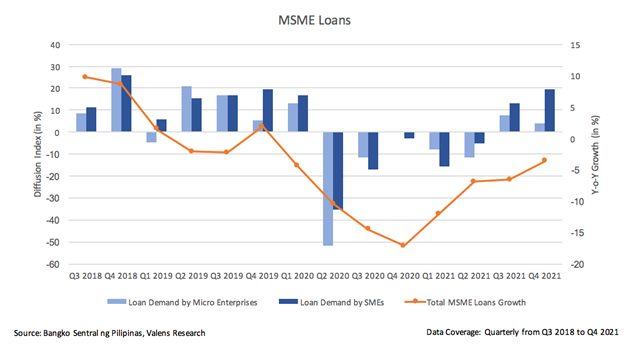MONDAY MACRO: The MSME sector is a crucial component to the economy, and it seems that it is finally on the path to recovery

The pandemic lockdowns sent MSMEs into a whirlwind of operational and financial stress. With most of these businesses having smaller balance sheets and limited access to financing, the government stepped in and established relief measures to lighten their financial burden.
A big reason for the government intervention is because, as a significant contributor to GDP, the recovery and growth of MSMEs is closely tied to the growth of the overall economy.
Today, we look at two indicators to gauge the impact of the government’s stimulus measures on MSMEs and see where the sector is in terms of recovery as well as approximate the pace of growth and growth trajectory.
Philippine Markets Newsletter:
The Monday Macro Report
Powered by Valens Research
Micro, Small, and Medium Enterprises (MSME) are the backbone of the Philippines’ economy. By definition, MSMEs are businesses with an asset size of less than PHP 100 million and employ less than 200 workers—these include your local sari-sari stores, self-owned online businesses, corner milk tea shops, and even small private enterprises.
MSMEs account for 99% of all business establishments in the country, employing about 60% of the workforce, and contributing approximately 40% of the country’s GDP, which highlights just how important this sector is to the economy.
So, since MSMEs generally don’t have sufficient assets or stored cash flows to weather major operational disruptions the way large corporations do, the government had to intervene.
The government enacted several policies and other regulatory relief measures in order to minimize the financial impact the pandemic had on MSMEs.
Small Business Corporation (SBC), the financing arm of the Department of Trade and Industry, cut interest rates to essentially zero and relaxed the lending requirements for MSMEs as part of the COVID-19 Assistance to Restart Enterprise (CARES) program. That is, in addition to SBC’s PHP 10 billion loan assistance given under the Bayanihan 2 Act.
Furthermore, the BSP temporarily relaxed credit risk weights of MSME loans from 75% to 50% in the calculation of capital adequacy ratio, as well as allowed the use of peso-denominated loans to MSMEs as an alternative reserve requirement compliance tool.
The efforts by SBC and the BSP freed up capital and allowed banks to extend credit in support of the survivability and future growth of MSMEs. That said, how have these policies affected the state of the MSME sector in actuality?
To quantify this, we will be looking at two indicators: the diffusion index for MSME loan demand and total loans to MSMEs.
The diffusion index for loan demand is the percentage difference between banks reporting an increase in demand for MSME loans and those reporting a decrease. Intuitively, a positive diffusion index means that there’s higher loan demand from MSMEs and increased willingness for growth, and vice-versa.
Meanwhile, the higher the total loans extended to MSMEs, the higher the probability of surviving the pandemic, the greater the capacity for future growth, and the faster the recovery of the MSME sector as a whole.

Total MSME loan growth and demand fell considerably during the beginning of the pandemic lockdowns in Q2 2020.
Loan demand fell to a trough of -52% for micro-enterprises and -35% for small and medium enterprises, staying in the negatives up until Q2 2021. Total loan growth, on the other hand, remained in negative territory through 2021.
With the government lowering interest rates, relaxing requirements, and infusing capital to keep the MSME sector afloat, one would assume more positive results. In reality, however, the headwinds to this sector’s growth were much stronger than the tailwinds.
Overall credit standards in 2020 were tight due to a weakening in banks’ profitability, reduced risk tolerance, deterioration of borrowers’ credit profiles, and a generally unfavorable economic outlook.
Basically, even with the government’s stimulus measures, banks weren’t as willing to extend loans to MSMEs and, looking at the demand trend, MSMEs weren’t as willing to borrow either.
That said, demand and total MSME loans have picked up recently. Demand has inflected positively in Q3 2021 and total loans, while still in the negatives, have started to pick up beginning in Q1 2021.
A boost in the MSME sector could quicken the economic recovery of the Philippines considering the significant role it plays. As the effects of the pandemic continue to dwindle, it is likely that MSME loan growth and demand, and consequently the sector’s recovery, would be strengthened considerably.
About the Philippine Markets Newsletter
“The Monday Macro Report”
When just about anyone can post just about anything online, it gets increasingly difficult for an individual investor to sift through the plethora of information available.
Investors need a tool that will help them cut through any biased or misleading information and dive straight into reliable and useful data.
Every Monday, we publish an interesting chart on the Philippine economy and stock market. We highlight data that investors would normally look at, but through the lens of Uniform Accounting, a powerful tool that gets investors closer to understanding the economic reality of firms.
Understanding what kind of market we are in, what leading indicators we should be looking at, and what market expectations are, will make investing a less monumental task than finding a needle in a haystack.
Hope you’ve found this week’s macro chart interesting and insightful.
Stay tuned for next week’s Monday Macro report!
Regards,
Angelica Lim
Research Director
Philippine Markets Newsletter
Powered by Valens Research
www.valens-research.com




